Gardeners who plan their gardens for wildlife often see that planning rewarded. The thing is, it’s sometimes hard to tell whether that reward is, as the computer programmers say, a feature or a bug. That is, we plant the plants we do because we’re interested in more than just the way the garden looks to us; we want it to attract the attention of the native fauna as well. But of course we also try to manage the garden so that there are plenty of beautiful plants and flowers throughout the year. So although we experience at least as many “pest” infestations as gardeners who plant for traditional garden beauty, we handle them differently.
For example, we have rather yucky-looking caterpillars attacking our beautiful passionvines to the point of defoliation at times. Sounds like a bug, right? But at the same time, it’s a feature: those caterpillars grow up to be beautiful butterflies. The damage to the plants is ephemeral; passionvines not only refoliate rapidly, they’re notorious for popping up at many different places in the garden, whether you wanted them there or not. (Again, hard to tell whether that’s a feature or a bug!)
The caterpillars of passionflower butterflies (the heliconians, Zebra, Gulf Fritillary, and Julia) eat the passionvines for the chemical defenses they provide. These caterpillars aren’t pests; they’re friends. We manage their infestations by planting enough of the vines in out-of-the-way spots that they can defoliate them, should the population require it, without sacrificing the lovely flowers everywhere.
The same is true for many of the “weeds” that grow in our diverse lawns. Cheesytoes , Spanish Needles, Trefoil (Desmodium sp.) , and the like—all of these are attractive to insects, which in turn attract lizards and birds and other wildlife to the garden. It’s not the same as a true ecosystem, but it’s nice to see some life in our yards, instead of the sterile no-fly zones of monocultured lawns, manicured weekly by gas-guzzling and noise-polluting “landscaping” crews.
There are, however, some pests that even the most tolerant of wildlife gardeners would like to control. In the second week of May I started to notice my Fiddlewood (Citharexlyum fruticosum) starting to come into flower, which is very exciting. This is a beautiful and ornamental native plant. The wildlife value of its flowers is limited, because it flowers for such a short time each year, but when it’s in flower, my goodness! It sure is pretty:
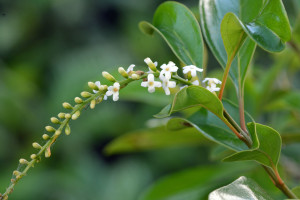
For more on the name of this plant, check out the post over at Eat the Weeds. I quote just a very few relevant words here (lightly edited):
When Linnaeus was naming plants, the English words “violin” or “fiddle” were not common in his time; plus, he preferred classical names. He knew the wood was used to make musical instruments so he named it “guitar wood shrub,” Citharexylum fruticosum. That got stretched into Guitar Tree and then Fiddlewood Tree. Now you know.
The most common name for the tree in the Caribbean islands is “old woman’s blisters”—read it’s used for a lot of ailments. Boiled twigs and decoctions are used if you’re chilled. When mixed with Strongback and Spoonbush it is used for sores. Boiled with mahogany, lignum vitae, Doctor Club roots, Snowberry and papaya latex, it was used to aid indigestion… or perhaps create it…. Also beware… insects of all sorts love the tree so you will encounter them, in numbers. The fruit pulp is edible but not prized. Do not eat the seeds.
Unfortunately for those who garden for aesthetics in addition to wildlife value, as noted by Green Deane in the above quote, this beautiful small tree serves as the larval host plant of a particularly annoying insect, a communal-feeding caterpillar, Epicorsia oedipodalis (I’ve written about it before). Since the time of that write-up, the UF/IFAS program has released a paper on them that wasn’t available to me until I started researching this post. (About time, guys!) Here’s the relevant section of the paper for gardeners and native plant enthusiasts:
This leaf-eating pest does no permanent damage to the plant, the shrub simply puts out a new flush of leaves. From an ecological perspective, the larvae themselves may serve as a valuable food source when baby birds need feeding during the spring dry season in Florida.
While I’m sure it’s true that the feeding damage isn’t permanent, and that this is indeed a worthy caterpillar, and a worthy moth too, for that matter, it comes in feeding hordes so large that they can completely defoliate young trees (and mine is only a couple of years old). So rather than letting nature take its course, I’ve been trying to manage the tree by systematically removing the caterpillars whenever I notice the characteristic signs of their presence: long webs running along the flower stalks (you can see it in the above picture if you click through to the full-sized version), skeletonized or discolored, dead, or dying leaves:
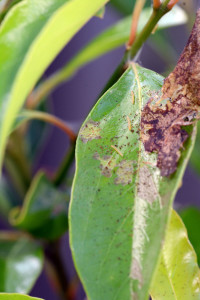
Maybe once my tree is a bit older, I’ll be able to practice the more ecologically sound approach and leave them on the tree. For now, though, I’m in protective mode. If you clicked through to look at the first picture of the fiddlewood flower, you noticed the long webbing running up the flower stalks; there are usually several caterpillars hiding in those protective zones. And since this hideout was running along the longest and nicest flower stalk, I needed help to remove the caterpillars without damaging the flowers. So I turned to my lovely and talented wife, whose up-close vision is far finer than mine, and whose hands are far steadier, for help:

If you look closely at the image above, you can see the little caterpillar in it:
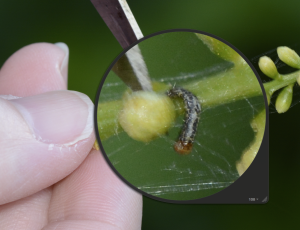
And here’s a larger one that she’d removed a minute earlier:
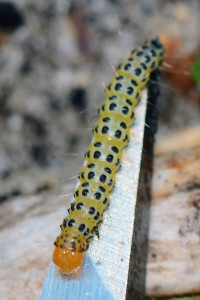
And here is a jar full of hundreds of these little guys that I’ve removed via leaf-pinching and simple snipping over the past several days:
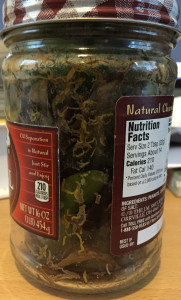
No, I’m not going to try to raise them. I’m just going to keep them in that peanut butter jar until the trashmen come to haul it away with the rest of the garbage next week.
These caterpillars also enjoy three other native plants in our region, two of which (Pigeon Plum and Lancewood) I have in my yard. Fortunately, according to the Featured Creature report, “less damage has been noted on these hosts.” (The third host, Sea Grape, is a close relative of Pigeon Plum.)
And, as usual with the UF/IFAS people, they suggest the nuclear option for homeowners interested in control of these infestations: Bacillus thuringiensis, also known as the way to make sure no insects survive in your yard ever. (They say that “this Lepidoptera-specific material is toxic to caterpillars but relatively non-toxic to beneficial organisms like predatory and parasitoid wasps, predaceous bugs, and vertebrates (birds, lizards, people, etc.).” Sorry, IFAS, there’s no way I’m going to apply that butterfly-killing bomb anywhere in my yard!
References
Kern, W. 2015. “Featured Creatures: Fiddlewood leafroller.” Publication number EENY-617. Available at http://entnemdept.ufl.edu/creatures/ORN/fiddlewood_leafroller.htm

I have three fiddlewood bushes that are about 10 – 12 feet high in my Coral Springs yard that flower for most of the year now unless Epicorsia oedipodalis gets the chance to eat them. This defoliating fiddlewood moth will leave nothing but twigs and branches unless I pull them off of the plants and destroy them on a regular basis. They are so bad that I am going to replace my fiddlewood in the near future since I do not have the time to be killing caterpillars every day, which I find myself having to do now. I didn’t have trouble with them for the first 2-3 years that I had the fiddlewood, but now they are a constant problem. I have no issue with providing food for caterpillars of any other type, but these do so much damage that I will kill them at any stage of life whenever I see them even though they are native to south Florida.
Thanks for the info on them. Keep up the good work!
I hear you, Brett. (Although I haven’t been monitoring my blog or comments for several months; sorry!) I’m in the middle of another infestation after ignoring the last one. The tree refoliated so quickly after the previous one that I ignored this one too, and it’s really getting stripped bare. I’m starting to reconsider the option of treating or, like you, perhaps replacing the plant entirely with something less pest-prone.
I purposely planted three 12 foot Fiddlewood trees at Markham Park for the huge number of birds that are there. I hope they will enjoy the feast and prevent the trees from being damaged too much. The birds were already on them for the seeds before they were off the truck!